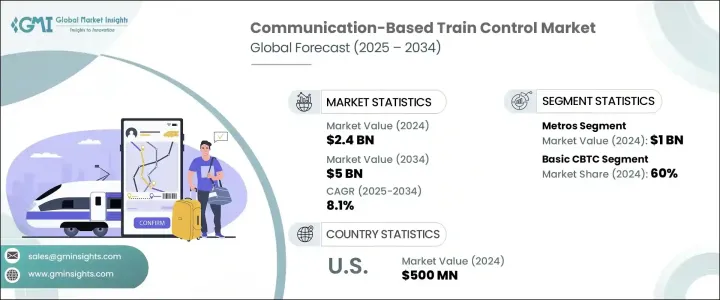PUBLISHER: Global Market Insights Inc. | PRODUCT CODE: 1740973

PUBLISHER: Global Market Insights Inc. | PRODUCT CODE: 1740973
Communication-Based Train Control Market Opportunity, Growth Drivers, Industry Trend Analysis, and Forecast 2025 - 2034
The Global Communication-Based Train Control Market was valued at USD 2.4 billion in 2024 and is estimated to grow at a CAGR of 8.1% to reach USD 5 billion by 2034, driven by the escalating demand for safe, efficient, and high-capacity rail transportation systems. As urbanization accelerates worldwide, cities are under immense pressure to modernize transit networks, minimize congestion, and meet rising passenger expectations. CBTC technologies have emerged as a critical solution, optimizing train movement, enhancing scheduling accuracy, and significantly reducing operational risks. The shift towards automation and real-time system management is becoming non-negotiable for transit authorities aiming to deliver superior service reliability and capacity expansion. Growing investments in digital infrastructure, the urgent need for sustainable mobility, and government funding for smart transportation initiatives are collectively accelerating CBTC adoption. In an era defined by smart cities and intelligent mobility solutions, CBTC systems are not only improving train safety and throughput but are also becoming fundamental pillars for the future of global public transit.

With the continued expansion of urban mobility needs, CBTC systems are transforming legacy infrastructures by reducing headway between trains, enhancing service frequency, and ensuring high operational reliability. Transit operators are leveraging seamless, real-time communication between trains and centralized traffic control to drive better scheduling, safer travel, and greater network responsiveness. Advancements in signaling technology, wireless communications, AI, predictive analytics, and connected infrastructure are further reshaping transit operations, enabling more intelligent, efficient, and sustainable rail networks. CBTC functionalities like automatic train protection, supervision, and operation facilitate continuous train-to-control center interaction, minimizing human error, improving maintenance planning, and supporting rapid real-time decision-making.
| Market Scope | |
|---|---|
| Start Year | 2024 |
| Forecast Year | 2025-2034 |
| Start Value | |
Table of Contents
Chapter 1 Methodology & Scope
- 1.1 Research design
- 1.1.1 Research approach
- 1.1.2 Data collection methods
- 1.2 Base estimates & calculations
- 1.2.1 Base year calculation
- 1.2.2 Key trends for market estimation
- 1.3 Forecast model
- 1.4 Primary research and validation
Chapter 2 Executive Summary
Chapter 3 Industry Insights
Chapter 4 Competitive Landscape, 2024
Chapter 5 Market Estimates & Forecast, By Trains, 2021 - 2034 ($Mn)
Chapter 6 Market Estimates & Forecast, By System, 2021 - 2034 ($Mn)
Chapter 7 Market Estimates & Forecast, By Automation Grade, 2021 - 2034 ($Mn)
Chapter 8 Market Estimates & Forecast, By Region, 2021 - 2034 ($Mn)
Chapter 9 Company Profiles




